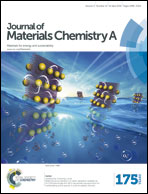Improving the electrochemical performance of layered Li-rich transition-metal oxides by alleviating the blockade effect of surface lithium†
Abstract
As promising cathodes for high-energy Li-ion batteries, the commercial application of layered Li-rich transition-metal oxides (LROs) is significantly prevented by their non-ideal cycling stability and rate capability. In this work, Li1.23Mn0.46Ni0.15Co0.16O2 samples are prepared by combining a solvothermal process and a Li2CO3 molten-salt method. When the molar ratio of Li2CO3 to transition-metal ions is 4 : 1, the obtained sample has the best electrochemical performance. Its initial discharge capacities at 20 and 300 mA g−1 are larger than 307.8 and 232.2 mA h g−1, respectively. After 200 cycles, the capacity retention ratio at 300 mA g−1 is still as large as 85.3%. In addition, we discovered that the relative content of lithium on the particle surface of the samples is more than that in the particle interior, and this distribution behavior of lithium is adjustable. In particular, we demonstrate for the first time that the overmuch enrichment of lithium on the particle surface will hinder the diffusion of Li-ions. This is the blockade effect of surface lithium, and this blockade effect can be alleviated by the Li2CO3 molten-salt method. This is the reason that the electrochemical performance of LROs can be greatly improved by the Li2CO3 molten-salt method.


 Please wait while we load your content...
Please wait while we load your content...